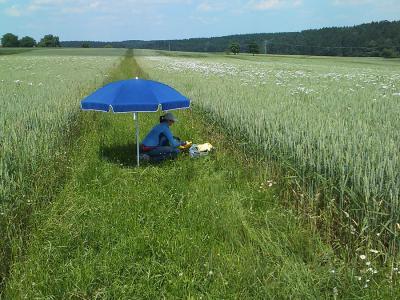Organic farming boosts biodiversity - at least that is the claim of organic farmers. But it depends. It's a $35 billion business and there are plenty of gigantic organic mega-farms that aren't diverse at all.
In practice, the number of habitats on the land plays an important role alongside the type and intensity of farming practices, according to a study of 10 regions in Europe and two in Africa published in Nature Communications. Organic farms still use plenty of toxic pesticides and more chemical fertilizer than conventional farms but they can support biodiversity when they consciously conservce different habitats on their holdings.
The authors investigated the contribution of organic farming to supporting farmland biodiversity between 2010 and 2013. Researchers wanted to explore whether organic farms are home to more species than their conventional neighbors so they used uniform methods across Europe to capture data and analyze it to establish the impact of farming methods and intensity and of landscape features on biodiversity.

Earthworm sampling on a grass verge between fields in Southern Bavaria. Credit: S. Wolfrum/TUM
The study investigated farms in twelve regions with different production systems. In each region, farms were selected randomly, half of them certified organic for at least five years. In Switzerland, grassland-based cattle farms were studied and in Austria the study looked at arable farms. In Italy and Spain, researchers focused on farms with permanent crops such as wine and olives, and on small-scale subsistence farms in Uganda.
"Organic farming is beneficial to the richness of plant and bee species. However, observed benefits concentrate on arable fields," says
Technische Universität München (TUM),
Prof. Kurt-Jürgen Hülsbergen, whose group analyzed 16 Bavarian dairy farms.
More species because of field boundaries
More species were found in organic arable fields than in non-organic fields. In contrast, there was little difference in grasslands or vineyards. Organic farming benefited the four taxonomic groups of plants, earthworms, spiders and bees – which were sampled as surrogates for the multitude of creatures living on farmland – in different ways. In general, more species of plants and bees were found on organic than on non-organic fields, but not more species of spiders and earthworms.
If types of field boundaries such as grass verges or hedges were included in the comparison, the difference between organic and non-organic decreases. "Obviously, most species found in fields on organic farms tend to be concentrated in boundary areas on non-organic farms. There was little difference in the total number of species on the farms," explains Max Kainz, who headed the sub-project at TUM. The occurrence of rare or threatened species did not increase on organic farms, according to Kainz.
Even organic farms need to increase habitats
To sustain farmland biodiversity, which is currently under grave threat, researchers have identified complement organic farming methods with dedicated efforts to conserve habitats. To increase the number of habitats, the authors of the study recommend adding structural elements, such as woods, grass verges and fallow land, to farms. "Surprisingly, viewed across all regions, we did not find a higher number of natural habitats on organic farms than non-organic farms," reports Kainz.
"However, it was clear that habitat diversity is the key to species diversity," adds Prof. Hülsbergen. He continues: "The results of the study underline the importance of maintaining and expanding natural landscape features – something that the EU's Greening Program has been trying to accomplish." If these additional habitats are different to the rest of the farm, for example hedges in grassland farms or herbaceous strips in arable farms, they have a huge impact on the biodiversity of a farm.





Comments